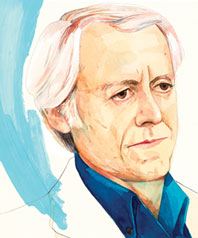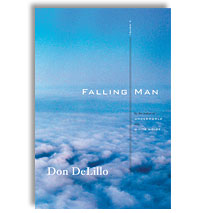
It’s easy, after nearly four decades of practice, to point out the faults of a Don DeLillo novel: Poke at one of his characters very softly and he tips over sideways; the plots all collapse under the weight of jokes and set pieces and non sequiturs and dystopic razzle-dazzle; everyone speaks, regardless of social class, like French and German theorists leading seminars on the phenomenology of the epistemology of the metaphysics of the philosophy of science; every subject, from math to rock music to college football, gets crowbarred into the narrow scope of his pet obsessions—conspiratorial plots, the intoxicating nature of crowds, modern art, the schism between image and reality. In fact the faults in DeLillo’s work are so obvious and central that they’re actually not faults at all: They’re the whole point. In the same way that Lindbergh loaded The Spirit of St. Louis with extra fuel at the expense of safety and reliable steering, DeLillo has deliberately handicapped his books to allow them to cover territory that traditional realism could never possibly approach. For DeLillo, it would be redundant, even immoral, to produce highly structured plots in a culture that generates endless plots on its own and then folds us into them without our consent (cf. the War on Terror)—so instead he writes plotless novels about plots, in which secret narratives (terror, assassination, the illegal distribution of psychotropic drugs) run with frightening momentum behind a foreground in which everyone tries, plotlessly, to digest or thwart or avoid or ignore or deal with the consequences. As the narrator of White Noise proclaims, grandly, “All plots tend to move deathward. This is the nature of plots.” DeLillo’s work is thus feast or famine. If you like what he’s doing, it’s hard to imagine anyone doing it better—in his best work (White Noise, Libra, the feverish opening of Underworld), he writes to an almost inhumanly high standard. If you don’t like it, however, chances are you will very deeply not like it. As Jonathan Lethem once put it, “He’s either as great as I thought he was when I thought he made all other writing look silly or he’s a total disaster.”
Given all of this, September 11 seems like both the worst and the best possible subject for a DeLillo novel. On the plus side, all of his signature obsessions clearly intersect in the chaos of that morning—a secret plot leading to a spectacular mass disaster that’s immediately absorbed into the permanent impermanence of the 24-hour news cycle. It’s like the JFK assassination (the subject of Libra) magnified exponentially and, just as a bonus, imported to the city he grew up in and writes best about. But while the subject would certainly benefit from DeLillo’s artistic strengths, it might not tolerate his weaknesses. Even six years later, I’m not sure the nation is ready to submit its largest collective emotional wound to the wry metaphysician of supermarkets and advertising jingles. After all, it was precisely DeLillo’s brand of postmodern irony—chilly, intellectual, superior, detached—that was supposed to have died that morning, or at least to have learned to keep its proper distance.
In his new novel, Falling Man, DeLillo parries such objections in advance, and in a typically clever way. The “falling man” of Falling Man turns out to be Falling Man, a performance artist who appears around the city in the weeks after 9/11 leaping from high places—only to be caught by a safety harness and suspended, midair, dressed like a businessman, in the posture of someone falling from the World Trade Center. Bystanders are understandably shocked, offended, and confused. The New School hosts a panel called “Falling Man as Heartless Exhibitionist or Brave New Chronicler of the Age of Terror”; the Guggenheim invites him to leap from its top floors “at scheduled intervals over a three-week period.” DeLillo, then, has built his novel around a neat symbol of the problem of the very existence of 9/11 art. (To some critics, this cleverness probably just confirms the original objection.) Falling Man, in other words, raises all the relevant questions about Falling Man: Too soon? Too painful? Suitably reverent? Overly reverent? Exploitative? Healing or wounding? Which should we prefer? And what can art possibly add to an event we’ve already experienced and reexperienced so often?
It turns out that numbness (to tragedy, the world, each other) is DeLillo’s essential theme. He painstakingly avoids the ready-made lexicon of 9/11—Twin Towers, ground zero, 9/11, heroes, Giuliani, The Pet Goat—in favor of simple, unsacred nouns like “the planes.” Everything happens “after the planes.” When the buzzwords do show up, they hit with surprising force: Even September feels obscene and holy.

In Falling Man, the real fallout of 9/11 is not political but existential. The planes cut everyone loose from whatever anchors of normality allowed them to relate to each other and the world: “There was a deep fold in the grain of things, the way things pass through the mind, the way time swings in the mind.” The book focuses on Keith Neudecker, an attorney who goes to work with all the usual professional baggage—an estranged family, a temper, a mild poker habit—and emerges covered in blood and ash and burdened by the kind of deep ennui we haven’t seen since the heyday of postwar France: Like the hero of Camus’s Stranger, Keith is so paralyzed by the absurdity of everyday life he’s practically catatonic, his detachment broken only by the occasional impulse toward sex and violence.
DeLillo has always taken a dangerously provocative approach to terrorists. In his 1991 novel Mao II, the semi-autobiographical protagonist Bill Gray basically equates them with novelists: Both, he says, “alter the inner life of the culture”; it’s just a question of medium and scale—where Dickens and Beckett used paper and ink, terrorists use bombs and buildings and the evening news. And by the early nineties, according to Gray, terrorists were already better at it: “In societies reduced to blur and glut,” he says, “terror is the only meaningful act…Only the terrorist stands outside.” (The critic James Wood thought this notion was so ridiculous it might stop all novelists everywhere from ever making proclamations about society again.) In Falling Man, DeLillo treats the subject a little more subtly. At the end of each of the book’s three parts, the narrator abandons Keith and his family to take us inside the mind of one of the 9/11 hijackers, Hammad, a member of the Hamburg cell who struggles with his doubts and secular urges. (“Late one night he had to step over the prone form of a brother in prayer as he made his way to the toilet to jerk off.”) We follow him from a spartan apartment in Germany to the American Gulf Coast to the last moments of the attack itself. In some ways these are the most compelling pages of the book, because they’re infected by what Hammad feels as “the magnetic effect of plot.” DeLillo refuses to villainize the terrorists; instead, he gives us a taste of the power of 9/11 from the other side. Hammad seems to find in the terror plot the same kind of religious purpose and beautiful order that Keith finds in poker—in fact, as Keith sinks deeper into the totalizing system of cards, his life becomes increasingly terroristic—“He folded six more hands, then went all-in. Make them bleed. Make them spill their precious losers’ blood.” It’s a dangerous parallel, one that opens up DeLillo to accusations of moral relativism and insufficient outrage about mass murder.
Anyone who dismisses DeLillo as a glib ironist fundamentally misunderstands the nature of his power. He’s a deeply religious writer, practically a fanatic—the Jerry Falwell of secular transcendence. His novels are full of shamans and rituals, everything lit by the odd holy light that trickles down through the storm clouds of consumer culture. He’s constantly transmuting pop trivia into eternal sacrament. (A character in White Noise chants “Toyota Celica” until it becomes a mystic koan.) Falling Man is saturated with what Keith’s wife calls “the hovering possible presence of God.” After 9/11, everyone is looking for some kind of spiritual discipline: poker (“the funneled essence”), therapeutic wrist exercises (“an odd set of extensions and flexions that resembled prayer in some remote northern province”), and even, as a last resort, church.
Falling Man has all the elements of a best seller: an affair, the strained triangle of a small family, a galvanizing performance artist, the secret life of a terror cell, and of course catastrophic terrorism. But DeLillo resists the easy dramatic lure of all of this, choosing to answer the cataclysmic noise of 9/11 with a more difficult, more realistic human silence. Everything is muted and contemplative, every presence riddled with sad absences. It’s all evocative anomie, blunted affect, elliptical poetics. This is the source of the book’s strength but also its weakness: Characters enter the frame so detached, displaced, and disoriented that it’s hard for the reader to make any kind of emotional investment—and unfortunately the energy of DeLillo’s earlier work isn’t here to compensate for it. His engine is running much quieter now, and—although there’s some beautiful and genuinely moving writing—I found myself missing the old gaudy revving, wondering how the swaggering, hyperverbal crowd of White Noise might have discussed life after the planes.
SEE ALSO:
What to Read From the DeLillo Oeuvre